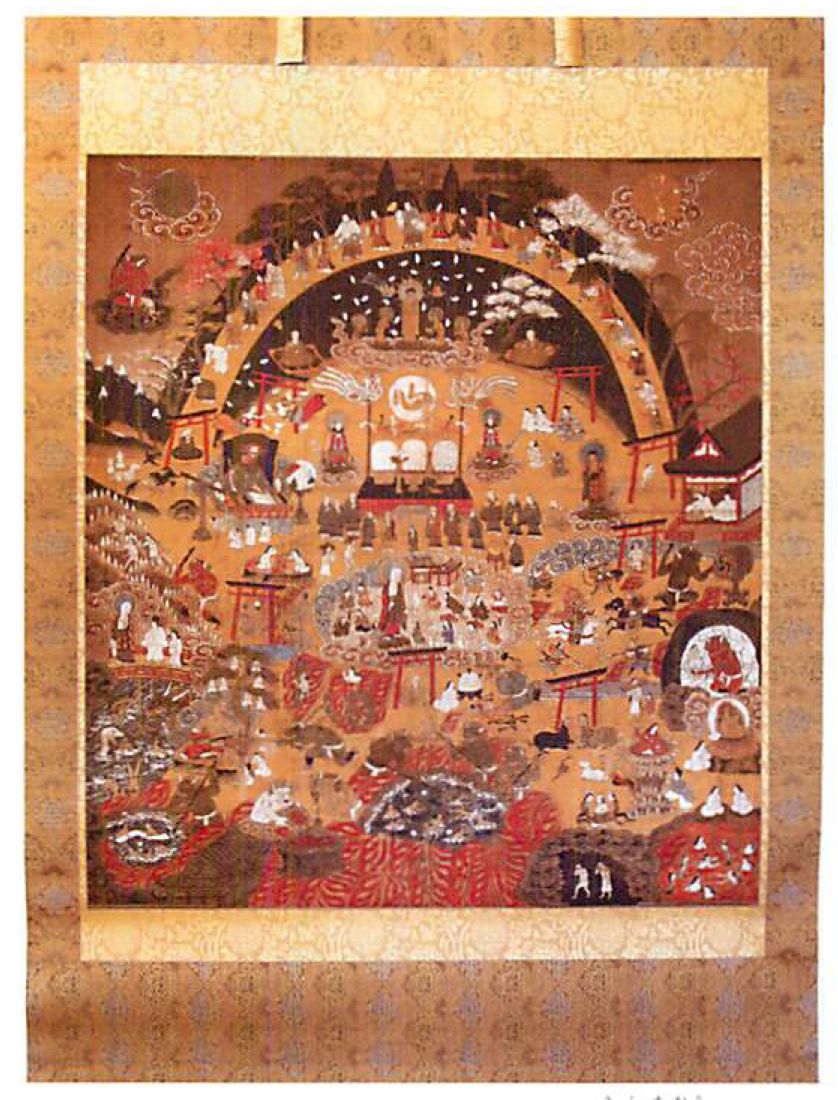| <所在地 瑞穂町箱根ケ崎132番地 円福寺内> | <Location: Inside Enpukuji Temple, 132 Hakonegasaki, Mizuho-machi> |
| 臨済宗建長寺派・北小山円福寺(ほっこざんえんぷくじ)に古くから伝わる宝物のひとつ。図は別名「地獄極楽之図」ともよばれており、人が生まれてきて成人し、やがて老人となる人生の移り変わりを示した部分が上部に描かれている。その下方には、人が生まれ変わって地獄・餓鬼(がき)・畜生の三悪道と阿修羅(あしゅら)・人間・天上を加えた六道(六界)を輪廻(りんね)していく部分、そして声聞(しょうもん)・縁覚(えんがく)・菩薩・如来の悟界を描いている。 | This is one of the treasures which have been passed down since ancient times in the Hokkozan Enpukuji Temple of the Rinzai Kenchoji sect.The image is also known by a different name, the "Image of Hell and Heaven." In its upper part, it depicts the transitions through life as a person is born, grows up, and ages.Below that, there is a section depicting the person being reborn through the six realms: the naraka (hell) realm, hungry ghost realm, animal realm, ashura realm, human realm, and deva (heaven) realm. It also depicts states of enlightenment: Sravaka, Pratyekabuddha, Bodhisattva, and Tathagata. |
| 詳しく見ると、上半部は円内に書かれた「心」の一字を中心とし、前に三具足と飯器を供え、風に翻る幡(ばん)一対を立てた卓を据え、卓前には法要を営む12名の僧、右側には雲上に立つ仏、菩薩各一と、礼拝する夫妻、子息等、左側には亡者を裁く閻魔王(えんまおう)と飛天二、後方に阿弥陀仏と四菩薩、その左右には座具に坐す比丘(びく)各一(声聞・縁覚か)を描き、それらの上部には大半円弧があり、下方には飯器に釘を打つ鬼や戦闘する甲冑(かっちゅう)の武士、動物等を描く。 | Look closely, and you will see that in the top half it depicts the character "心," or "heart" in a circle with dishes and the three implements for worship (an incense burner, flower vase, and candle stand) in front of it on a table with a pair of flags fluttering in the wind. In front of this table are twelve monks performing a Buddhist service. To the right is a Buddha and Bodhisattva standing on a cloud with a praying couple and their son. To the left is Yamaraja, who judges the dead, and Hiten (angels). Toward the rear are Amitabha and the four Bodhisattva. To the left and right are seated Bhikkhu (ordained monks): Sravaka and Pratyekabuddha. Toward the top is a large half-circle, under which are a demon hammering nails into dishes, a soldier in samurai armor, animals, and more. |
| この一幅は、諸国を巡歴して熊野信仰を広めていた熊野比丘尼(くまのびくに)の「絵解き」用具として作られたといわれ、諸人、特に女性に勧善懲悪(かんぜんちょうあく)を説くために使われたと推察されている。 | This single piece is said to have been created as an illustrative tool for Bikuni Kumano, who traveled through various countries spreading the Kumano faith. It was used to preach the concept of poetic justice to people, and to women in particular. |
| 大きさは、画面が縦140.6cm、横127.6cm、製作年代は中世末から近世初期と推定されている。文献資料によって、近世中期まで江戸やその周辺に熊野比丘尼が遊行(ゆぎょう)していたことは明らかであるが、本図はその態様を示す希少な民俗資料として東京都から平成元年3月24日に指定を受けている。 | It is 140.6 cm tall and 127.6 cm wide, and is estimated to date from between the middle ages and early modern era.It is clear from the literature that Bikuni Kumano wandered through Edo and the surrounding areas until the middle of the Modern Era. This painting was first designated as a rare folk artifact by the Tokyo Metropolitan Government on March 24, 1989. |
